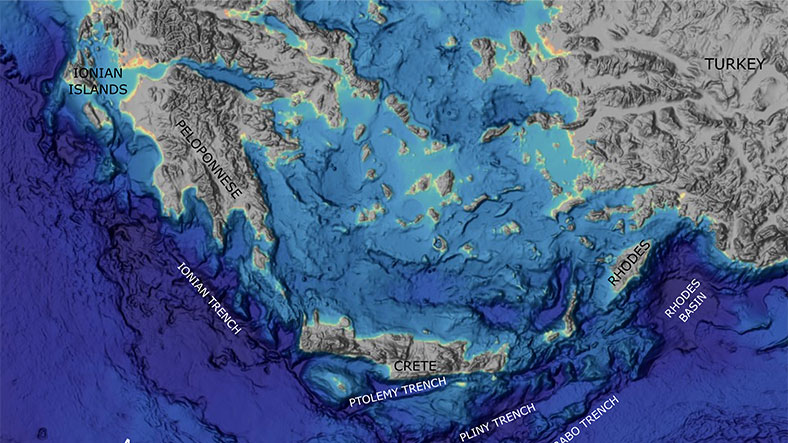Are these earthquakes on the Helen fault, which came to the agenda again after the 5.4-magnitude earthquake that occurred in the Mediterranean offshore today, herald a new disaster?
Monday, February 6, 7.7 and 7.6 earthquakes affecting 10 provinces, especially Kahramanmaraş, shocked the whole of Turkey. While the pain of tens of thousands of our citizens who lost their lives was still very fresh, the whole country was frightened even by the slightest earthquake.
Today in the evening in the Mediterranean off the “Helen’s bowThe earthquake with a magnitude of 5.4, which took place over “Could there be a big earthquake in the Aegean region very soon?” begs the question. While some experts state that there may be an earthquake at any time, others states that this earthquake is normal.
First, let’s take a look at what the Hellenic arc, where the earthquake took place, is.
The 5.4-magnitude earthquake did not occur in an ordinary location, unlike many other earthquakes in the Mediterranean. The point where the earthquake occurred is known as the Hellenic Arc and the Cretan Arc throughout history. An earthquake that took place in 365, which caused a submerged part of the island of Crete to rise and emerge. is a “fault line collection”.
The Hellenic arc, which is a point where different fault lines converge and caused dozens of earthquakes recorded throughout history, this fault, which is connected to the Fethiye Burdur fault, starting from the Ionian Sea, which is the neighbor of the Mediterranean, also has many “Subduction ZoneLet me also point out that.
Earthquakes in these Subduction Zones mainly cause massive tsunamis to occur in the seas and It can cause the surrounding settlements to be damaged by tsunami rather than earthquakes.
In addition, it has been determined that a total of 17 destructive earthquakes have occurred on the Hellenic arc since 1740. These earthquakes are respectively;
| Year of the Earthquake | Name of the Earthquake | Magnitude of the Earthquake |
|---|---|---|
| 1741 | Rhodes Earthquake | Unknown |
| 1743 | Antalya Earthquake | Unknown |
| 1922 | Karpathos Earthquake | Unknown |
| 1926 | Rhodes Earthquake | MS: 7.0 |
| 1926 | Finike Earthquake | MS: 6.8 |
| 1941 | Cyprus Earthquake | MS: 5.9 |
| 1949 | Karpathos Earthquake | MS: 7.2 |
| 1953 | Cyprus Papos Earthquake | MS: 6.1 |
| 1957 | Fethiye Earthquake | MS: 7.2 |
| 1959 | Koycegiz Earthquake | MS: 5.7 |
| 1969 | Kastellorizo Earthquake | MS: 6.3 |
| 1996 | Papos Earthquake | MS: 6.2 |
| 2003 | Antalya Earthquake | MS: 4.8 |
| 2005 | Kas, Antalya Earthquake | MS: 5.5 |
| 2009 | Crete Earthquake | MS: 6.2 |
| 2011 | Crete Earthquake | MS: 6.3 |
| 2020 | Crete Earthquake | Mw: 6.4 |
Could the recent earthquake in the Mediterranean be a harbinger of a bigger disaster?

Actually, the answer to this question both yes and no. When we look at the earthquakes on the Hellenic arc in history, we encounter thousands of earthquakes, large and small. While the energy accumulated after some small earthquakes is released by large earthquakes, in some cases medium and large-scale earthquakes can occur at frequent intervals, preventing a larger energy accumulation.
It should be noted that each fault line has different earthquake mechanisms and each earthquake has a different “maturation” process. Therefore, it is impossible to know with certainty whether a devastating earthquake will follow the 5.4 earthquake. Of course yourself “Earthquake Oracle” by introducing if you’re manipulating people’s fears that’s different.
RELATED NEWS
Facts About the ‘Earthquake Oracle’ Frank Hoogerbeets, Who Said He Known About the Kahramanmaraş Earthquake 3 Days Ago!
Earthquake researcher Baturhan Öğüt, in his statement on his Twitter account, Helen states that it shows no buildup on the spring. According to Öğüt, earthquakes of this magnitude do not occur on fault lines where tension accumulates.
RELATED NEWS
How exactly do the “Arab and African Plates”, which are the main reason why there are so many fault lines in Turkey, work?
As a result, although the 5.4-magnitude earthquake in the Mediterranean took place in a very dangerous location, it may not actually be a harbinger of a larger earthquake as thought. But of course we can’t know for sure..
